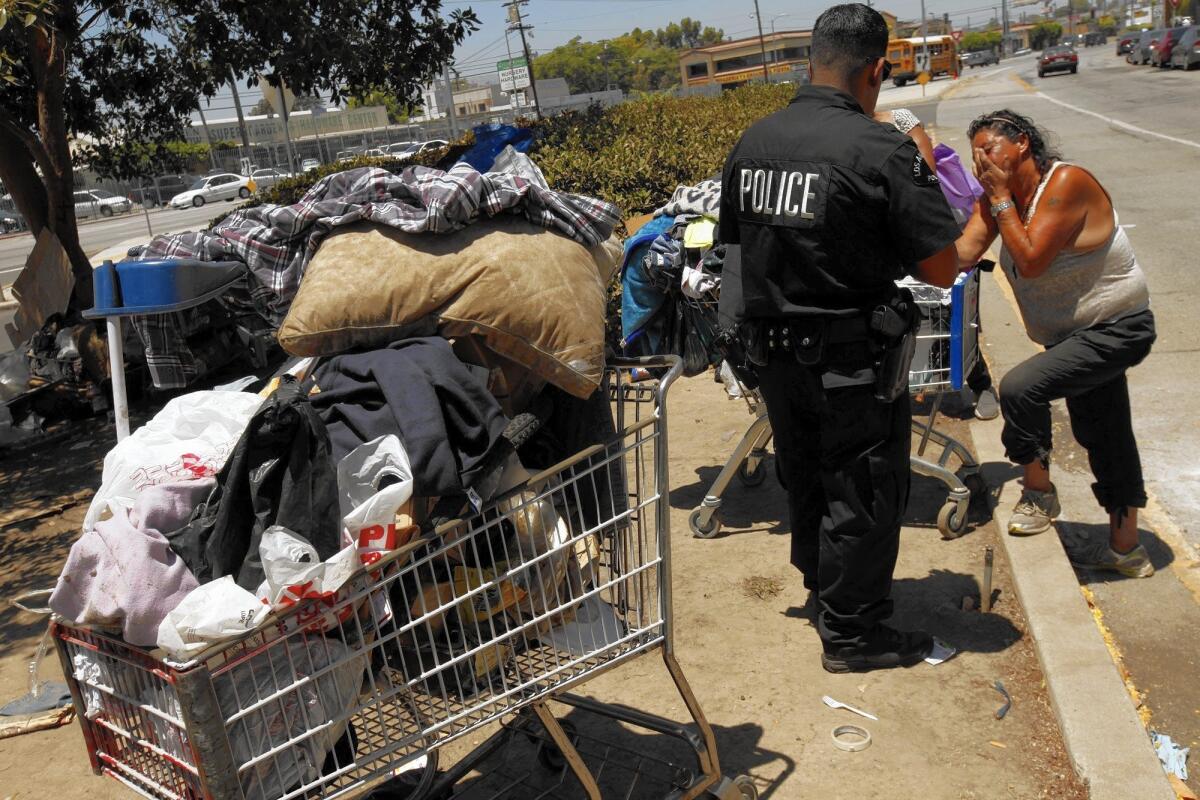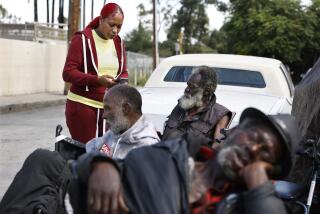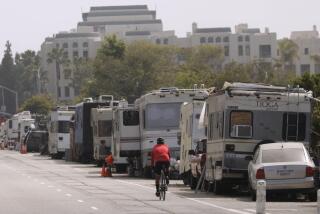Why L.A.’s homeless camp cleanups seem to be futile

When the workers in hazmat suits arrived there wasn’t much left to do.
Rosa Torres had received the mandatory 72-hour notice, posted on a tree beside her lean-to in the crescent-shaped median skirting North Hills Community Park.
She had moved about 20 shopping carts bulging with her belongings across Parthenia Place and deposited them in a nook just outside the park fence.
The workers sprayed some leftover debris with disinfectant and took it away in a big white truck, leaving the shopping carts behind.
Los Angeles Police Officer James McDonald, who monitored the cleanup, didn’t think Torres would be gone long.
“She’ll go somewhere else tonight and then come back,” McDonald predicted.
That’s exactly what she did. Today, two months later, Torres’ 20 carts are still lined end-to-end in the median like a mini-fortress. She lives under a blue plastic tarp suspended between a barely living shrub and her carts. She said she’s happy with her outdoor life. She’d consider moving into an apartment if one was provided. But she’s not eager for a change.
“I love you,” she said repeatedly. “I love America.”
As the city embarks on a $100-million initiative announced Tuesday to combat homelessness, the failed attempt to dislodge Torres from the median shows that in addition to legal and budgetary issues, there’s a moral quandary that inhibits the workers sent out to deal with the problem.
In its quest for a clean and attractive city, how far should society go in removing people like Torres from the street?
That day’s cleanup in North Hills has become a recurring story across Los Angeles as the homeless population spreads from downtown. In the 10 months that ended in July, at least 400 cleanups have taken place across the city, according to Bureau of Sanitation data.
Nearly 100 of those locations have been cleared more than once and a few repeatedly. The site cleaned the most — eight times — was on skid row, but two encampments in San Pedro at 7th and Palos Verdes streets were cleaned seven and six times, according to the city records.
The cleanups are concentrated in downtown and South L.A., but there have been several in the Valley. One San Fernando Valley location, on Rinaldi Street just west of the 5 Freeway, has been cleaned five times during that 10-month period.
As leaders in City Hall wrestle with legal questions about how to ameliorate the health, safety and aesthetic problems associated with the homeless, the action on the streets is often no more than a charade in which workers know little will change.
“If I were to be someone walking down the street, I’d say, ‘Am I paying for that?’” McDonald said later in an interview, reflecting on the futility of sending half a dozen workers to carry out a cleanup that would last perhaps a day or two.
A spokesman for the Bureau of Sanitation said Councilwoman Nury Martinez’s office requested the cleanup, but would not comment on why so few of Torres’ possessions were removed.
Jim Dantona, Martinez’s chief of staff, said Torres’ case was not typical. He cited other locations where large volumes of material had been removed. Even so, he acknowledged that those cleanups may have dispersed large encampments but did not get those homeless people off the streets.
“They moved away from the site and either went south or north,” Dantona said.
He said cleanups are preceded by visits from homelessness specialists who offer services.
“Ninety percent of the folks we talk to refuse the service whether it’s because of mental health or they don’t want it,” Dantona said.
McDonald, who has since moved on to another LAPD assignment, characterized Torres’ story as a dilemma that city workers face when weighing compassion for the down-and-out with their responsibility to maintain an acceptable quality of life for residents and business owners.
“We could arrest her every day for what she’s doing,” McDonald said. “Do you realize that a business pays retail $300 to $500 for a cart? She had at least 20 carts now. We arrest somebody who steals a car or bicycle for grand theft. Here she’s got $6,000 to possibly $10,000 of somebody else’s property.”
But arrest — most commonly on trespass or public drunkenness charges — has not proved a successful strategy.
“We’ve arrested people,” McDonald said. “They come right back. It’s a misdemeanor. It’s a $100 ticket.”
The defendants plead poverty.
“They tell us, ‘Yeah, I saw the judge. They say clean up this area on the way out, time served,’” McDonald said.
More often, the person is arrested and released with an order to clear out.
That hasn’t been effective with Torres, whose attitude, McDonald said, is, “I own this street.”
“We’ve written her so many release from custody citations, I don’t even know how many. But it hasn’t changed.”
In June, the Los Angeles City Council passed two ordinances giving city workers much more discretion in removing homeless people’s property. With only 24 hours’ notice, the city could issue a misdemeanor citation for being on public land and seize the offender’s property. If unclaimed after 90 days in storage, it could be destroyed.
After initially saying he supported the laws, Mayor Eric Garcetti said he would not enforce them until the council added safeguards against the confiscation of important personal items such as prescription medications and identification cards. He has also said he wants to reduce the laws’ criminal penalties for homeless violators.
“Those are important to me, that it be humane,” Garcetti said at the time. “We need to have an ordinance in place, but I wanted it to have that in it. And the one that went through didn’t have that, so I’m not signing it.”
The City Council is still considering amendments.
The lack of enforcement of the two ordinances hasn’t stopped the cleanups. More than a dozen took place in the seven days after they became law July 18, according to city records.
The cleanup of Torres’ camp occurred July 16. But the scene that day showed the internal struggle that city workers sometimes face at such moments.
A sanitation worker who declined to give his name spent several minutes on his cellphone conferring with a supervisor on what to do about Torres’ carts.
Finally, he told the crew to leave them. He explained that the 72-hour notice had covered only the median. Since the carts were no longer on the median, they couldn’t be moved. (In fact, it would have taken a different type of truck to cart them away without destroying them.)
“What business am I in?” McDonald asked rhetorically that day. “I’m here to enforce the law. Unfortunately, the three-day notice works against the people who complained. It defeats the purpose.”
At the same time, he sympathized with Torres.
“I’m not here to decide who is a member of this community and who is not,” McDonald said. “People on the street are very capable of taking care of themselves. I respect that.”
Sometimes, he said in the interview, his job brings him face-to-face with these conflicting interests — the complaining citizen on one side and the homeless person on the other.
“We’re like a referee,” he said. “‘Would you agree to move down for a couple of weeks?’” he’ll ask the homeless person. “‘I’ll take it,’” the business owner says.
But not always.
McDonald said sometimes business owners will ask that a homeless person be arrested on a Friday, knowing that the courts will be closed and they will get a weekend of relief.
“They know what the deal is: ‘Please arrest them today.’”
Twitter: @LATDoug
Times staff writer Ben Poston contributed to this report.
ALSO:
U.S. task force warns cities on efforts against homeless camps
Pope’s Philadelphia visit stirs excitement, but also anxiety for homeless
Homeless advocate Andy Bales, battling dangerous infections, warns of skid row health crisis
More to Read
Start your day right
Sign up for Essential California for news, features and recommendations from the L.A. Times and beyond in your inbox six days a week.
You may occasionally receive promotional content from the Los Angeles Times.







